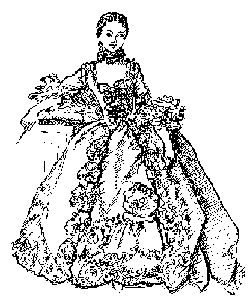
A lady circa. 1760
This rich gown shows the undergarments above and below the waist. Some gowns only showed the petticoat below the waist or, less commonly, no underlayers at all.
Here, above the waist, we see the stomacher, a fancy front of a corset (or stays) that is designed to be seen. If the gown were closed, the corset would be plain. A popular design of bows in decreasing size was called an eschelle stomacher.
There are always those willing to go to any length for fashion, but in this period corsets were not particularly designed to contort the form. As with a modern bra, the corset would fit the lady's shape and size, and the lacing at the back allowed for adjustment. They also had very lightly boned stays called jumps.
Below the waist we can see the elaborate petticoat. Since most petticoats in this period were designed to be seen, they were often rich embroidered and trimmed, especially at the front.
The skirts here are spread over wide hoops, probably of cane or rattan. Sometimes quilted under-petticoats were used to hold out the skirts but these were less comfortable, adding weight and constriction around the legs. However, in winter, they could provide warmth.
Under the hoops and corset, the lady will be wearing a shift or chemise next to her skin. This will be knee-length, but with sleeves to the elbow, and the froth of lace commonly seen at the elbow edge of sleeves was part of the shift, not the gown. Similarly, any lace trimming around the neckline was usually part of the shift.
You will see that it would take some time to get out of these clothes. But as the ladies wore no drawers, it was not always necessary! Anyway, because the clothes were elaborate, ladies at home wore "undress" much of the time, a loose, pretty robe similar to a heavy negligee.
The lady will be wearing stockings, gartered at the knee. This lady is doubtless wearing stocking of silk with woven patterns or embroidered motifs, called clocks. For everyday wear cotton or wool was more common. Her shoes, likely of silk to match her gown, will have quite a high heel.
Note that at this period hair is dressed neatly close to the head. The wildly enormous hair styles come later in the century. Caps, generally elaborate and frivolous, were fashionable for all women, single or married, but not required.